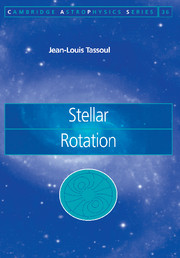2 - Rotating fluids
Published online by Cambridge University Press: 15 August 2009
Summary
Introduction
As we may infer from the observations, most stars remain in a state of mechanical equilibrium, with the pressure-gradient force balancing their own gravitation corrected for the centrifugal force of axial rotation. Accordingly, theoretical work has tended to focus on the figures of equilibrium of a rotating star, assuming the motion to be wholly one of pure rotation. However, detailed study of the Sun has demonstrated the existence of large-scale motions in its convective envelope, both around the rotation axis and in meridian planes passing through the axis. Theoretical work has shown that largescale meridional currents also exist in the radiative regions of a rotating star. Moreover, as new results become available, it is becoming increasingly apparent that these regions contain a wide spectrum of turbulent motions embedded in the large-scale flow. All these problems are the domain of astrophysical fluid dynamics – a field that has developed quite slowly until recently.
Over the course of the past fifty years, however, meteorologists and oceanographers have made important advances in our knowledge of the behavior of rotating fluids. I thus find it appropriate to review some dynamical concepts that are applicable to both the Earth's atmosphere and the oceans. As we shall see, all of them play a key role in providing useful ideas for quantitative analysis of large-scale motions in a rotating star.
- Type
- Chapter
- Information
- Stellar Rotation , pp. 25 - 64Publisher: Cambridge University PressPrint publication year: 2000

